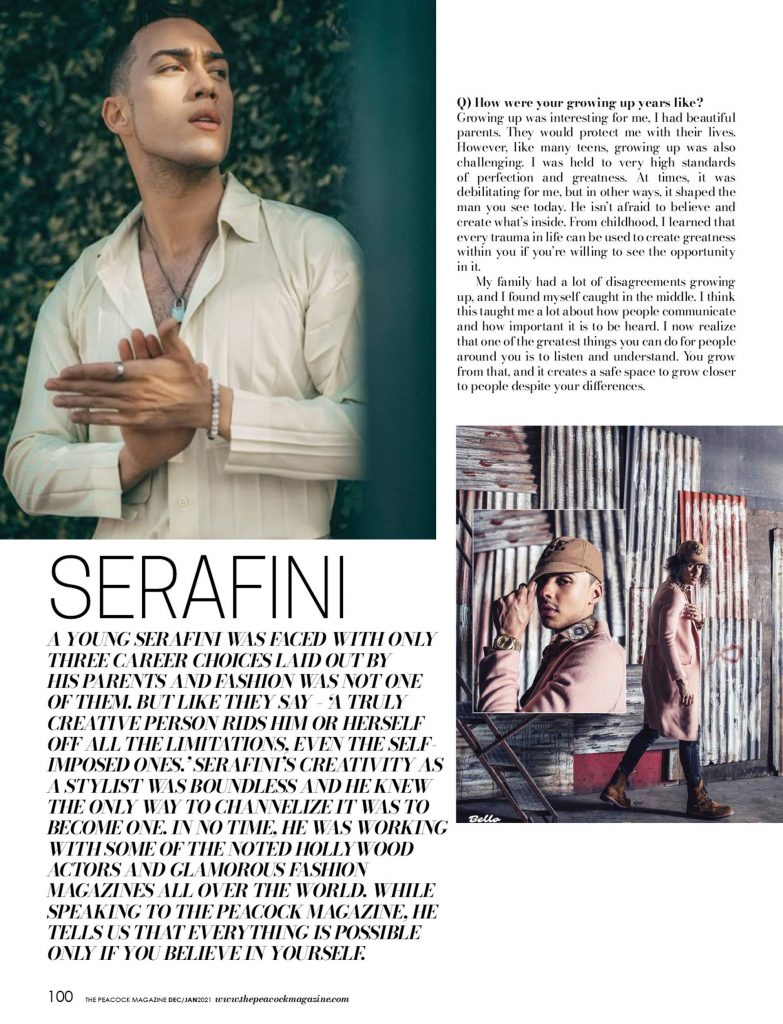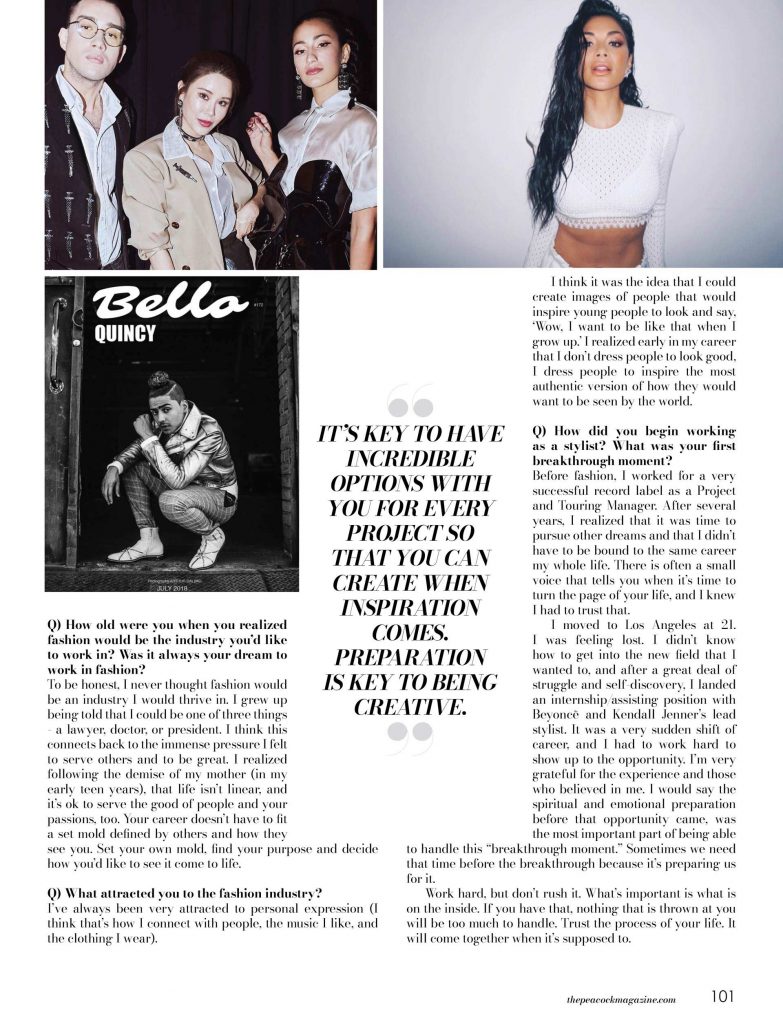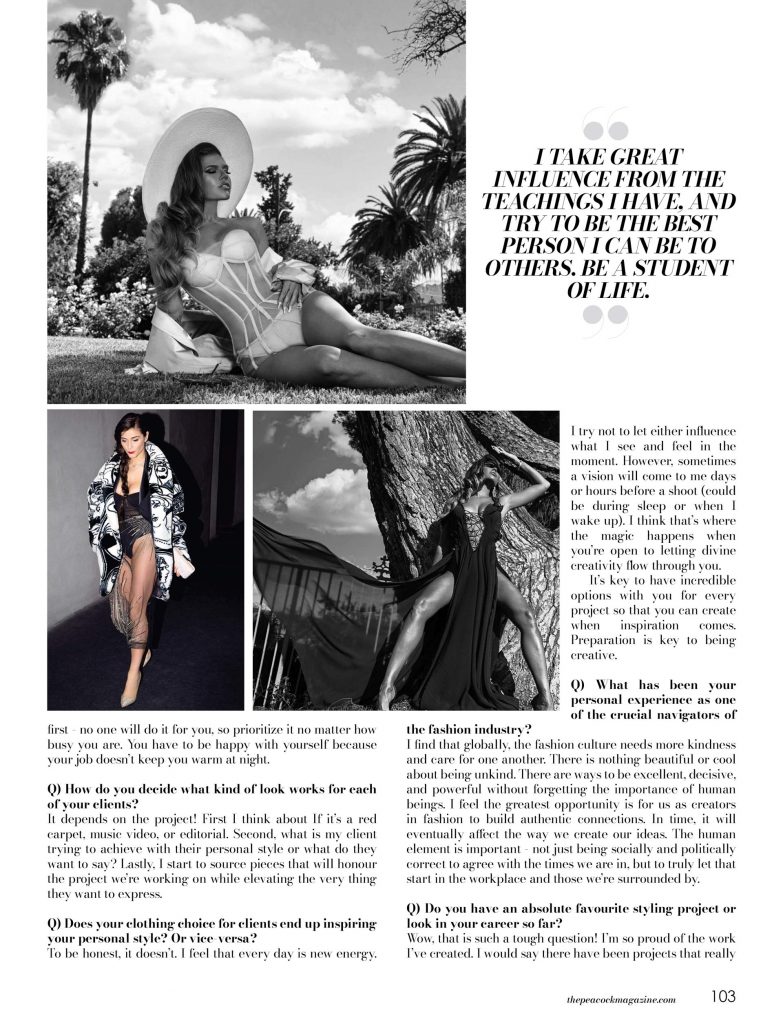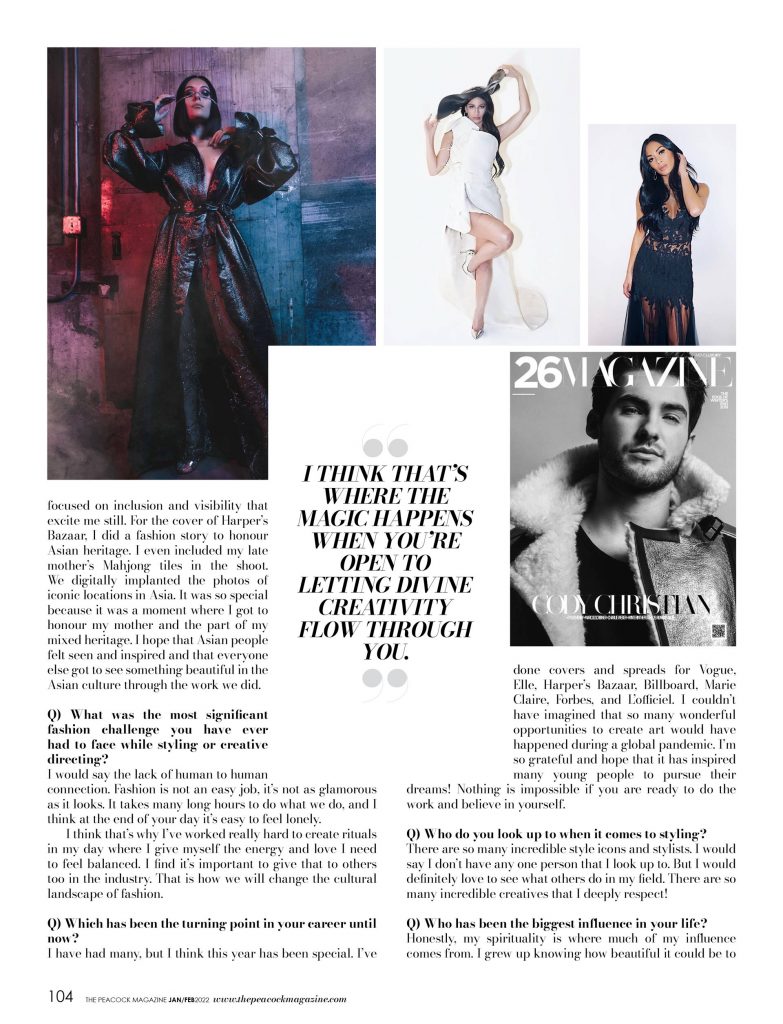
CREDITS – All images sourced from the artist.
A young Serafini was faced with only three career choices laid out by his parents and fashion was not one of them. But like they say – ‘a truly creative person rids him or herself off all the limitations, even the self-imposed ones.’ Serafini’s creativity as a stylist was boundless and he knew the only way to channelize it was to become one. In no time, he was working with some of the noted Hollywood actors and glamorous fashion magazines all over the world. While speaking to The Peacock Magazine, he tells us that everything is possible only if you believe in yourself.
[Q] How were your growing up years like?
Growing up was interesting for me, I had beautiful parents. They would protect me with their lives. However, like many teens, growing up was also challenging. I was held to very high standards of perfection and greatness. At times, it was debilitating for me, but in other ways, it shaped the man you see today. He isn’t afraid to believe and create what’s inside. From childhood, I learned that every trauma in life can be used to create greatness within you if you’re willing to see the opportunity in it.
My family had a lot of disagreements growing up, and I found myself caught in the middle. I think this taught me a lot about how people communicate and how important it is to be heard. I now realize that one of the greatest things you can do for people around you is to listen and understand. You grow from that, and it creates a safe space to grow closer to people despite your differences.

[Q] How old were you when you realized fashion would be the industry you’d like to work in? Was it always your dream to work in fashion?
To be honest, I never thought fashion would be an industry I would thrive in. I grew up being told that I could be one of three things – a lawyer, doctor, or president. I think this connects back to the immense pressure I felt to serve others and to be great. I realized following the demise of my mother (in my early teen years), that life isn’t linear, and it’s ok to serve the good of people and your passions, too. Your career doesn’t have to fit a set mold defined by others and how they see you. Set your own mold, find your purpose and decide how you’d like to see it come to life.
[Q] What attracted you to the fashion industry?
I’ve always been very attracted to personal expression (I think that’s how I connect with people, the music I like, and the clothing I wear).
I think it was the idea that I could create images of people that would inspire young people to look and say, ‘Wow, I want to be like that when I grow up.’ I realized early in my career that I don’t dress people to look good, I dress people to inspire the most authentic version of how they would want to be seen by the world.
[Q] How did you begin working as a stylist? What was your first breakthrough moment?
Before fashion, I worked for a very successful record label as a Project and Touring Manager. After several years, I realized that it was time to pursue other dreams and that I didn’t have to be bound to the same career my whole life. There is often a small voice that tells you when it’s time to turn the page of your life, and I knew I had to trust that.
I moved to Los Angeles at 21. I was feeling lost. I didn’t know how to get into the new field that I wanted to, and after a great deal of struggle and self-discovery, I landed an internship/assisting position with Beyoncè and Kendall Jenner’s lead stylist. It was a very sudden shift of career, and I had to work hard to show up to the opportunity. I’m very grateful for the experience and those who believed in me. I would say the spiritual and emotional preparation before that opportunity came, was the most important part of being able to handle this “breakthrough moment.” Sometimes we need that time before the breakthrough because it’s preparing us for it.
Work hard, but don’t rush it. What’s important is what is on the inside. If you have that, nothing that is thrown at you will be too much to handle. Trust the process of your life. It will come together when it’s supposed to.

[Q] How did life chart its course after the breakthrough moment?
Well, it was rather quick, I had only assisted for 6 months or so before I started to get hired by other celebrities. I had to leave that opportunity behind and believe that I could do it on my own. I had done this seemingly intense boot camp, and I believed I was ready to take on the next chapter. No one thought I was ready, but you have to believe in yourself. You can’t wait for others to see what you see in yourself.
[Q] Growing up did you ever think you would end up working with the bigwigs of the industry?
I always had a sense that I would be part of affecting culture, and I always wanted to spread light, God, and hope to the people around me. So, I think it’s been a natural progression of that. You happen to see it with people who are recognizable to you, but I know the key is realizing that whether it’s for someone others know, or it’s your friend from school, it’s equally important to be hopeful to the people around you.
[Q] Could you describe your styling aesthetics?
I would rather say how it’s been described by others. (laughs) I’ve been told it’s an aesthetic of people looking powerful and expensive or very cool and individualistic. I think both are very exciting to create for people.
[Q] What does your usual workday look like?
It’s different every day. I think there is a lack of structure since I work a freelance job. It requires me to create my own sense of structure. So, I always create a routine (ie. coffee rituals, times of meditation to connect with the higher power, working out, and time to enjoy the music I love).
The new jobs and work opportunities exist around these routines. You have nothing if you don’t take care of yourself first – no one will do it for you, so prioritize it no matter how busy you are. You have to be happy with yourself because your job doesn’t keep you warm at night.

[Q] How do you decide what kind of look works for each of your clients?
It depends on the project! First I think about If it’s a red carpet, music video, or editorial. Second, what is my client trying to achieve with their personal style or what do they want to say? Lastly, I start to source pieces that will honour the project we’re working on while elevating the very thing they want to express.
[Q] Does your clothing choice for clients end up inspiring your personal style? Or vice-versa?
To be honest, it doesn’t. I feel that every day is new energy. I try not to let either influence what I see and feel in the moment. However, sometimes a vision will come to me days or hours before a shoot (could be during sleep or when I wake up). I think that’s where the magic happens when you’re open to letting divine creativity flow through you.
It’s key to have incredible options with you for every project so that you can create when inspiration comes. Preparation is key to being creative.
[Q] What has been your personal experience as one of the crucial navigators of the fashion industry?
I find that globally, the fashion culture needs more kindness and care for one another. There is nothing beautiful or cool about being unkind. There are ways to be excellent, decisive, and powerful without forgetting the importance of human beings. I feel the greatest opportunity is for us as creators in fashion to build authentic connections. In time, it will eventually affect the way we create our ideas. The human element is important – not just being socially and politically correct to agree with the times we are in, but to truly let that start in the workplace and those we’re surrounded by.
[Q] Do you have an absolute favourite styling project or look in your career so far?
Wow, that is such a tough question! I’m so proud of the work I’ve created. I would say there have been projects that really focused on inclusion and visibility that excite me still. For the cover of Harper’s Bazaar, I did a fashion story to honour Asian heritage. I even included my late mother’s Mahjong tiles in the shoot. We digitally implanted the photos of iconic locations in Asia. It was so special because it was a moment where I got to honour my mother and the part of my mixed heritage. I hope that Asian people felt seen and inspired and that everyone else got to see something beautiful in the Asian culture through the work we did.

[Q] What was the most significant fashion challenge you have ever had to face while styling or creative directing?
I would say the lack of human to human connection. Fashion is not an easy job, it’s not as glamorous as it looks. It takes many long hours to do what we do, and I think at the end of your day it’s easy to feel lonely.
I think that’s why I’ve worked really hard to create rituals in my day where I give myself the energy and love I need to feel balanced. I find it’s important to give that to others too in the industry. That is how we will change the cultural landscape of fashion.
[Q] Which has been the turning point in your career until now?
I have had many, but I think this year has been special. I’ve done covers and spreads for Vogue, Elle, Harper’s Bazaar, Billboard, Marie Claire, Forbes, and L’officiel. I couldn’t have imagined that so many wonderful opportunities to create art would have happened during a global pandemic. I’m so grateful and hope that it has inspired many young people to pursue their dreams! Nothing is impossible if you are ready to do the work and believe in yourself.
[Q] Who do you look up to when it comes to styling?
There are so many incredible style icons and stylists. I would say I don’t have any one person that I look up to. But I would definitely love to see what others do in my field. There are so many incredible creatives that I deeply respect!
[Q] Who has been the biggest influence in your life?
Honestly, my spirituality is where much of my influence comes from. I grew up knowing how beautiful it could be to have a personal connection to God and the Universe. I take great influence from the teachings I have, and try to be the best person I can be to others. Be a student of life.

[Q] What are some of the things that nobody talks about being a fashion stylist?
The hours. It’s a lot of late nights, and hard work that is often not well paid. It’s something I haven’t seen stylists talk about publicly. We work so hard to do what we do!
[Q] One celebrity with the most iconic wardrobe.
Audry Hepburn.
[Q] What exciting projects are you working on currently?
Well, I’m excited about the upcoming fashion weeks. I’m currently planning on attending and working with talent. This is such an exciting time for us.
[Q] What are your future plans?
I have been creative directing and styling for years now. I may take some career shifts and pursue other dreams. I don’t think anyone has to stay in a specific box their whole life. I’m excited to explore more in music, inspirational speech, and writing. Stay tuned – incredible things are coming and I can’t wait to share them with you!
